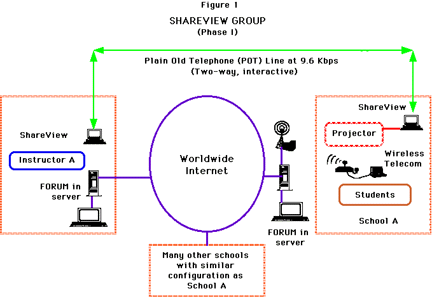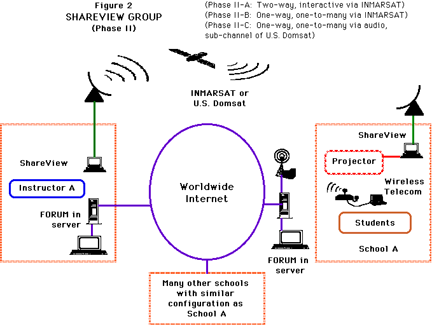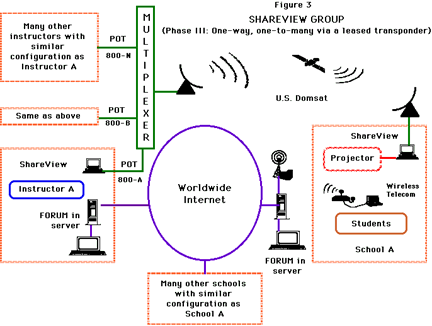

Affordable Integrated Education Technology
for
Underserved Populations in the U.S. and Around the World
May 1, 1995
I. PROJECT SUMMARY
The Consortium for the Advancement of Affordable Distance Education (CAADE) proposes to develop and demonstrate a high-performance electronic communications infrastructure which can integrate mass delivery of instructional materials via satellite with innovative low-cost options for management of multimedia materials within computer-equipped schools connected to Internet.
The goal is to use experiences gained from tests on the new all-digital NASA Advanced Communication Technology Satellite (ACTS), and from recent developments of Computer-Mediated Multimedia Systems (CMMS) via Plain Old Telephone Services (POTS), terrestrial Internet and wireless telecommunications, in order to come up with alternative approaches to distance education. The increased capabilities of personal computers (PCs), Internet, wireless telecommunications, and digital satellites will converge in improving and reforming education instruction efficiently and affordably for the underserved population in the U.S. (and later around the world). This proposed technology will also help overburdened Internet.
II. CAADE PROJECT
Addressing telecommunications needs of underserved schools
in the U.S. in the initial phase project, CAADE will develop and demonstrate
a new high-performance electronic communications infrastructure which combines
the power of computers via POTS, low-to-medium speed terrestrial Internet
and (where appropriate) wireless telecommunications, and digital satellite
technologies as a new model for distance education. This infrastructure
is an integrated approach to electronic distance education using CMMS over
more than one (wire and wireless) delivery and distribution platform, and
an integration of mass delivery of instructional materials via satellite
with innovative low-cost options for terrestrial feedback and interaction
using Internet and wireless telecommunications. The result will be increased
access to richer learning environments while enhancing interactivity and
sharing of information among teachers and students. This approach will also
help to take bandwidth pressures off the now-overburdened Internet.
The goal of initial phase project is to provide science teachers and their
students in the U.S. with a single, integrated distance education system.
The system will utilize the well-accepted interface developed for the World
Wide Web to integrate:
This project will demonstrate 1) that, in a digital world, the melding of wireless and wireline technologies into an integrated system is possible at reasonable cost at almost any urban or rural site in the U.S., 2) that, in a distributed environment, mass instruction with pre-packaged materials can coexist and complement highly individualized instruction, and 3) that, in computer-mediated teaching (as in science teaching), learning can be both experiential and collaborative over distance.
The CAADE project opens up opportunities for increased feedback and collaborative learning within a distance education program that can be broadly deployed, is relatively inexpensive, is easy to use and promotes collaborative work.
III. NEED AND PROBLEM
1. Need
An approach to motivating young people in science is to engage them in problem solving, focusing on concrete real-life problems they can relate to. With computers, simulation and experiential learning with hands-on applications are possible. Using distributed computer-mediated technologies, collaborative experiences over interactive networks have also been demonstrated to greatly enhance the acquisition and learning process.
Providing such opportunities to students in rural areas is a challenge. Commercial telecommunications companies will not invest in providing the high capacity lines to connect low traffic sites. What is more, line charges are often prohibitively expensive. Using the NASA satellite as a testbed, the CAADE project will seek to transfer ACTS experience to the new commercial satellites which now blanket North America, reaching rural schools with digital data which can be accessed and redistributed using terrestrial wireless and wireline services. This model is extensible to public libraries, small business, local governments, volunteer organizations, medical services and other users in underserved regions.
2. Problem
A highly desirable component of any teaching-learning process
is interaction between teacher and students. The distance education model
predominantly used is to deliver lessons as one-way video broadcasts, with
a return telephone path for questions and feedback. While live telephone
call-ins from students at remote sites is better than no teacher-student
interaction, it greatly restricts the number of students that can give feedback
during any given class. There is often no convenient way for students to
send questions to the instructor, to share ideas among themselves after
the scheduled broadcast time has ended, or to access other relevant information.
Furthermore, any follow-on learning activities allowing students to work
collaboratively are difficult to manage. What is needed is an affordable,
highly interactive, well-integrated and easy-to-use approach to closing
the loop between mass delivered and highly personalized communication and
learning.
IV. PROPOSED SOLUTION
In a typical distance education environment, the need is for high bandwidth large volume information transmission from the teacher to the student(s), with lower bandwidth response-feedback communication from the student to the teacher, and with each other.
For the delivery of multimedia courseware, CAADE members will use a) direct digital broadcasting satellite (DDBS) receivers connected to on-school-site PCs, b) modified routers for local buffering/switching, c) advanced digital video compression software operating at 9.6 Kbps or higher through POTS, d) and packet-switched terrestrial networks. Wireless telecommunications will also be demonstrated which enable students to access nearby Internet nodes. (FORUM and other computer-mediated multimedia conferencing technologies will be considered for this purpose.) The intent is to bridge the last-mile to classrooms that do not have access to a telephone line and to school buildings that have no direct connection to terrestrial Internet.
For purposes of this project, the CAADE consortium has been tentatively divided into three work groups and an administrative group to serve the needs of end-users of the CAADE system:
1. The COMPUTER COMMUNICATION GROUP will develop and demonstrate high-performance multimedia technologies and software for Mac and PC which are operational over POTS lines at 9.6/14.4/28.8 Kbps. These and FORUM via terrestrial Internet will be inexpensive and user-friendly multimedia and conferencing systems intended to enrich interactions between teachers and students, using graphic and whiteboard capabilities and incorporating audio and video clips with hypermedia linking.
The goal of this group is to develop robust and up-to-date systems that can be assembled for less than $10,000 per school. Units will be provided at each demonstration site. By using standard personal computers, equipped for low and medium speed communications, a large number of users can be networked together.
Phase I (Click here for large diagram)

Phase II (Click here for large diagram)

Phase III (Click here for large diagram)
